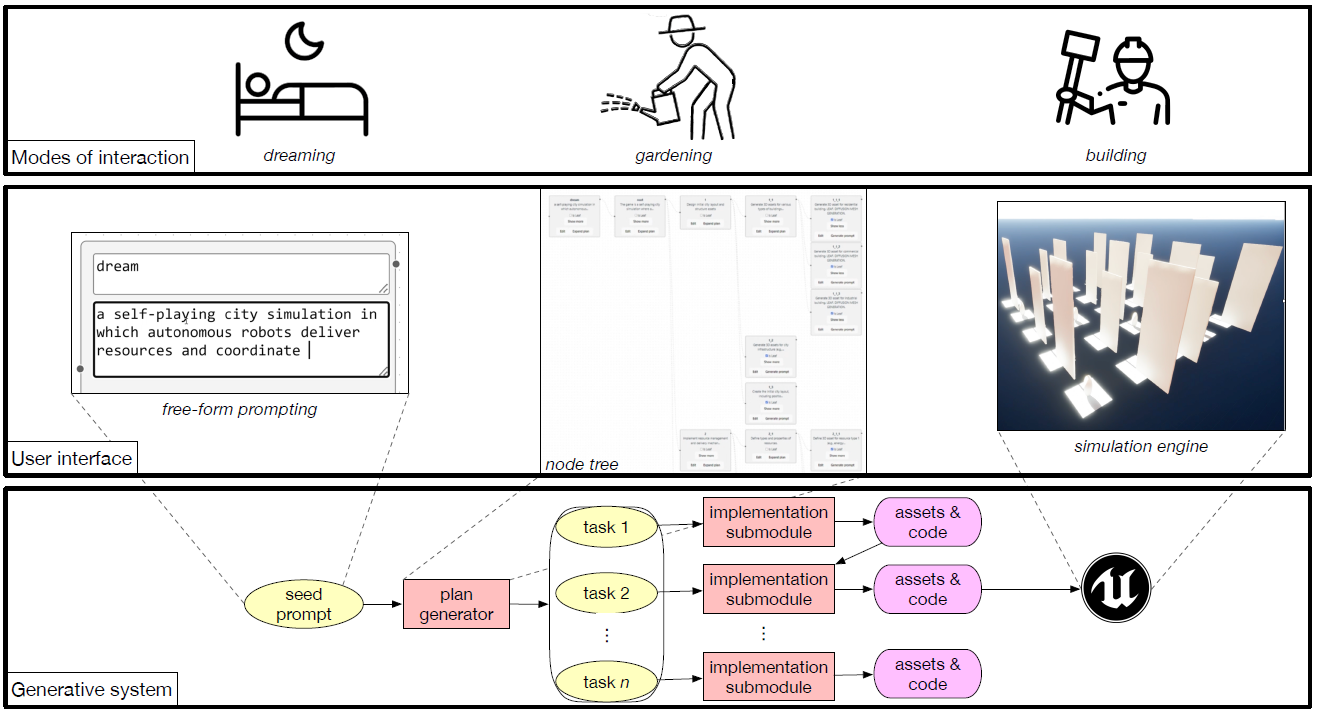The rise of generative AI has led to significant advancements in assistive tools for content creation, from text and code to images and three-dimensional (3D) assets. However, existing AI models in game design typically respond to direct user prompts without working autonomously toward broader goals or exhibiting emergent behaviors.
Procedural content generation (PCG), long employed in game development, compresses environments into algorithms for dynamic content generation, but it often lacks finer control for designers. Recent tools powered by LLMs have been used in game design but focus on tasks like level generation and character creation without the capacity for hierarchical task management.
Previous work includes symbolic algorithms that offer greater designer control but fall short in automating high-level tasks. DreamGarden bridges this gap by offering a semi-autonomous AI assistant for game design that generates human-editable plans and actionable tasks in Unreal Engine.
Unlike prior models, DreamGarden allowed users to influence the generative process and focused on enabling rapid prototyping in game development. The paper filled gaps by integrating LLM-powered procedural content generation with designer-friendly interfaces to bridge autonomy and creativity in game design.

DreamGarden is a game design assistant facilitating diverse modes of user interaction. Users can enter loose, open-ended, dream-like ideas via free-form text into a planning module which will recursively refine them into actionable design plans—a garden to be pruned or expanded. Implementation submodules then carry out the resultant task sequence, either via autonomous visual feedback or responding to direct user feedback and code edits.
System Design and Implementation Methodology
The DreamGarden system aimed to assist game designers in creating functional game simulations from a single high-level prompt by employing LLMs and a modular, adaptive user-friendly interface. The system was designed with three key goals: leveraging LLMs for game design, enabling user intervention during the generation process, and validating the approach through an in-depth usability study with both professional and novice designers.
The system used multiple specialized AI agents to manage the various tasks involved in game design, including a recursive hierarchical planning that broke down high-level goals into detailed sub-goals. A node-based graphical user interface (GUI) allowed users to visualize and interact with the hierarchical planning tree, making adjustments to sub-plans and expanding or pruning nodes.
Key components included the code generation submodule, which created C++ code for Unreal Engine actors and generated layouts for these actors. Additionally, the system incorporated procedural mesh generation, diffusion-based asset creation, asset downloading, and feedback mechanisms to handle errors and optimize the simulation. The GUI facilitated user interaction with the planning tree and tasks, providing a flexible environment for refining game simulations.
System Performance and User Feedback
The researchers explored the usability and performance of DreamGarden, an AI-assisted game design system. The system's functionality was assessed through qualitative user feedback and experimental manipulation of system parameters. During experimentation, various hyperparameters, such as tree depth and branching factors, were manipulated, revealing the system’s tendency to subdivide tasks unnecessarily, especially in more straightforward scenarios. However, larger tree depths facilitated the system’s progress in complex situations, allowing incremental improvements to the code and better task orchestration.
Users expressed mixed opinions regarding the system’s utility, particularly for planning and prototyping phases, with some praising its potential in breaking down game development tasks. However, concerns were raised about its limitations in handling nuanced or complex game mechanics, with the system sometimes inventing tasks beyond its capability. Participants also commented on the lack of fine-grained control over the output, with some reluctant to use it for creative projects requiring higher artistic control.
The authors highlighted the importance of user interactivity, with users desiring more intermediate visual feedback during code generation. Additionally, users suggested system improvements, including more intuitive code summaries, better handling of error messages, and greater flexibility in asset management within the GUI.
Analysis and Design Insights
The researchers highlighted key findings from the DreamGarden system's usability study, emphasizing the need for improved performance in handling complex scenarios. They suggested integrating more thorough few-shot prompting techniques and better utilization of available documentation.
Enhancements in code presentation and structured outputs were proposed to improve user experience. The hierarchical planning approach showed promise for broader applicability, including creative tasks beyond game development. Users expressed a desire for greater control, with suggestions for a system that adjusted its autonomy level. Future iterations should focus on increasing system legibility and allowing more seamless interaction within the Unreal Engine Editor while maintaining a balance between user intervention and system autonomy.
Conclusion
In conclusion, DreamGarden represented a promising advancement in AI-assisted game design, allowing developers to transform high-level prompts into actionable plans within Unreal Engine. The system's ability to generate hierarchical plans and support user intervention highlighted its potential for enhancing creativity and efficiency in game development.
While challenges remain in handling complex scenarios and providing users with greater control, feedback from the usability study indicated substantial value in its intermediary outputs. Future enhancements should focus on refining user interactions, improving performance, and expanding applicability to other creative domains beyond game development, ultimately fostering a collaborative environment where AI and designers can co-create effectively.

 *Important notice: arXiv publishes preliminary scientific reports that are not peer-reviewed and, therefore, should not be regarded as definitive, used to guide development decisions, or treated as established information in the field of artificial intelligence research.
*Important notice: arXiv publishes preliminary scientific reports that are not peer-reviewed and, therefore, should not be regarded as definitive, used to guide development decisions, or treated as established information in the field of artificial intelligence research.
Journal reference:
- Preliminary scientific report.
Earle, S., & Parajuli, S. (2024). DreamGarden: A Designer Assistant for Growing Games from a Single Prompt. ArXiv. https://arxiv.org/abs/2410.01791